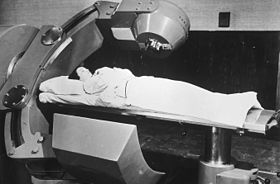Cobalt therapy
This article needs additional citations for verification. (December 2016) |
| Cobalt therapy | |
|---|---|
 | |
| Other names | Cobalt-60 therapy |
| Specialty | oncology |
Cobalt therapy is the medical use of
History
This section needs additional citations for verification. (November 2022) |
Before the development of medical

The invention of the nuclear reactor in the Manhattan Project during World War II made possible the creation of artificial radioisotopes for radiotherapy. Cobalt-60, produced by neutron irradiation of ordinary cobalt metal in a reactor, is a high activity gamma-ray emitter, emitting 1.17 and 1.33 MeV gamma rays with an activity of 44 TBq/g (1,200 Ci/g). The main reason for its wide use in radiotherapy is that it has a longer half-life, 5.27 years, than many other gamma emitters. However, this half-life still requires cobalt sources to be replaced about every 5 years.
In 1949, Dr.
Dr.
Current use
The role of the cobalt unit has partly been replaced by the
Isotope
As used in radiotherapy, cobalt units produce stable, dichromatic beams of 1.17 and 1.33 MeV, resulting in an average beam energy of 1.25 MeV. Cobalt-60 has a half-life of 5.2713 years.[10]: 39
See also
- Gamma knife
References
- ^ a b https://www.irsn.fr/sites/default/files/documents/professionnels_sante/documentation/syllabus_chapitre_5.pdf
- from the original on 22 June 2022. Retrieved 22 June 2022.
Present price of radium is $25 per milligram, $25,000 per gram, $700,000 per ounce.
- ^ "Cobalt-60: Explore our legacy of nuclear medicine innovation". University of Saskatchewan. n.d. Archived from the original on 8 March 2022. Retrieved 22 June 2022.
In 1951, University of Saskatchewan medical physicist Dr. Harold Johns and his graduate students became the first researchers in the world to successfully treat a cancer patient using cobalt-60 radiation therapy. This innovative technology—dubbed the "cobalt bomb" by the media—revolutionized cancer treatment and saved the lives of millions of cancer patients around the world.
- ^
"Cultural Heritage Assessment: Buildings in the South Street Hospital Complex, London, Ontario" (PDF). p. 46. Archived (PDF) from the original on 4 May 2020. Retrieved 3 May 2020.
It is perhaps fitting, given the symbolic emphasis that the War Memorial Children's Hospital placed on turning the spoils of war to the benefits of peace, that this facility became the first place in the world to use the Cobalt-60 Beam Therapy Unit (the Cobalt Bomb) in the treatment of a Cancer patient, on October 27, 1951.
- ^ "Celebrating the 60th anniversary of the world's first cancer treatment with Cobalt-60 radiation". London Health Sciences Centre. 27 October 2011. Archived from the original on 27 April 2022. Retrieved 23 June 2022.
On October 27, 1951, the world's first cancer treatment with Cobalt-60 radiation took place at Victoria Hospital. This marked an important milestone for both the fight against cancer and Canada's emergence as a leader in the field of radiotherapy. Today, London Health Sciences Centre is pleased to acknowledge the 60th anniversary of this tremendous medical breakthrough.
- .
- PBS NewsHour. Archivedfrom the original on 18 June 2022. Retrieved 23 June 2022.
The always energetic man struggled to go back to the Disney studios after the operation, but the chemotherapy and cobalt X-ray treatments drained him of both his creative and physical powers. He was rushed back to St. Joseph's Hospital two weeks later and died of "circulatory collapse" on the morning of Dec. 15.
- ^ "Nuclear Medicine Dedication At Cedars Hospital". National Library of Israel. B'nai B'rith Messenger, January 11 1963. Retrieved 13 July 2022.
- ^ "Cobalt, Linac, or Other: What Is the Best Solution for Radiation Therapy in Developing Countries? - International Journal of Radiation Oncology, Biology, Physics".
- PMID 19285593.
